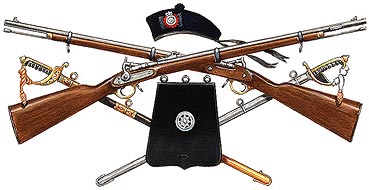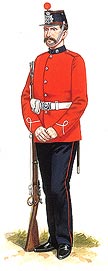Militia And Volunteers
Militia in the 19th Century

 |
| On the left a Company Officer in Dress uniform and on the right a Company Officer in Undress patrol jacket and forage cap. |
During the Napoleonic War The Surrey Militia formed part of the South Coast Defensive Army and helped guard French prisoners of war. In 1811, they served in Ireland and in the next year were briefly deployed to France. Many militiamen were hurriedly sent to reinforce the Guards regiments just prior to the battle of Waterloo; they fought wearing Surrey Militia jackets. In 1808 a “Local Militia” was instituted and whole regiments of volunteer infantry were drafted into the Militia. Their importance lapsed between 1816 and 1852, as the external threats to the Country decreased.
 |
| Private of the 2nd Royal Surrey Militia. He is armed with the Snider Rifle. |
In 1852, there was a revival of the Militia, as a result of the aftermath of the 1848 French revolution, and from 1854, recruits were voluntary only, as the ballot system ended. The 1st Surrey Militia established its Headquarters at Richmond, whilst The 2nd Surrey Militia was based at Guildford. Officer Mess meetings occurred at the “White Hart”, Guildford, which still functions at the top of the High Street. Uniforms became the same pattern as the regular forces, but with silver not gold lace. The Permanent Staff consisted of the Adjutant, Sergeant Major, ten sergeants and seven drummers.
Volunteers
In May 1859, as a result of public anxiety of the possibility of French aggression, Lord Derby’s Government authorised the formation of Volunteer Rifle Corps. The staff of these small, but enthusiastic units, similar to the Militia, included an Adjutant, a Sergeant Major and two or three permanent staff instructors detached from the regular line battalions. There were twenty six Volunteer Corps in Surrey. In 1861, these Corps were grouped together into Surrey Rifle Volunteer Battalions for administrative reasons.
The 1st Battalion included the 2nd, 4th, 8th, 20th, and 26th Corps. The 2nd Battalion consisted of the 6th, 9th, 11th, 12th, 15th, and 16th Corps, whilst The 3rd Battalion were the 5th, 13th, 14th, 17th, 18th, and 22nd, to which the 24th was added later. The 4th Battalion only included the 10th and 23rd. This latter battalion was to have a complicated future lineage, becoming The 22nd Battalion of The London Regiment (The Queen’s) in 1908 and eventually The 6th (Bermondsey) Battalion of The Queen’s in 1937. In 1881, there were 254,000 Volunteers under arms in the United Kingdom.
Related
